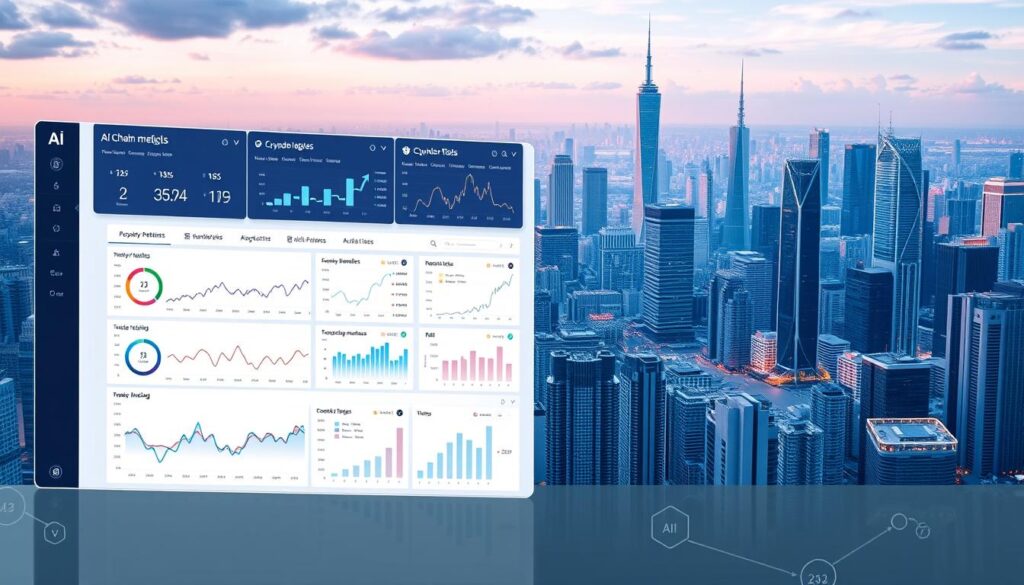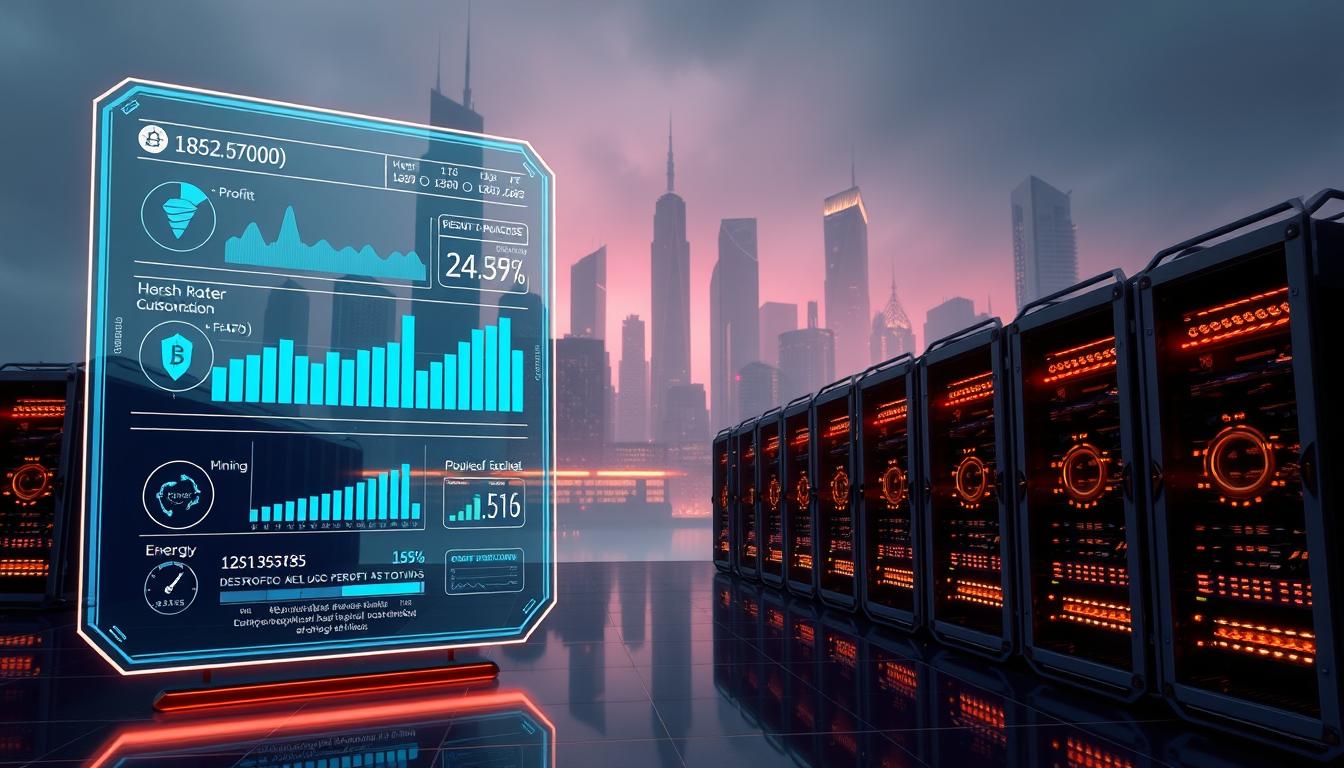Now Reading: Computer Vision Blockchain Data Visualization: A Guide
- 01
Computer Vision Blockchain Data Visualization: A Guide
Computer Vision Blockchain Data Visualization: A Guide

Making sense of complex digital networks is a major challenge today. Decentralized systems generate enormous amounts of information every second. This information can be hard to understand without the right tools.
Specialized visual representation is essential for unlocking the meaning within this data. It turns confusing numbers into clear pictures. Both experts and newcomers can grasp complex ideas through effective data visualization in blockchain.
This guide explores a powerful new approach. We combine advanced pattern recognition with modern ledger systems. The goal is to extract actionable insights from massive, fast-moving networks.
For example, some networks require over 21,000 GB of storage. Others have ledgers exceeding 150 TB. Traditional analysis methods struggle with this scale. New techniques are needed to see the story the numbers tell.
Key Takeaways
- Visual tools are critical for understanding complex decentralized network information.
- Traditional analysis struggles with the massive scale of modern ledger systems.
- New techniques combine pattern recognition to automate insight extraction.
- Good visual representation makes complex data understandable for everyone.
- This guide provides practical methods for transforming raw information into clear insights.
- The volume of information, like 150 TB ledgers, demands specialized approaches.
Exploring the Fundamentals of Blockchain and Data Visualization
Modern ledger systems create a unique type of digital record. This record is decentralized and spread across many computers. Understanding its core principles is the first step toward effective interpretation.
Key Blockchain Concepts
This technology functions as a distributed ledger. Its key features are decentralization, transparency, and immutability. Information is stored in blocks linked by cryptography.
Structures like Merkle trees ensure data integrity. This is very different from traditional database systems. Specialized decoding is needed for proper analysis.
Blocks, transactions, and smart contracts form the network’s backbone. Data flows through a peer-to-peer structure. This creates new paradigms for handling large-scale information.
Importance of Visual Data Interpretation
Raw blockchain data is incredibly complex. Looking at numbers and codes directly provides little value. Sophisticated techniques are required to find meaningful patterns.

Visual tools transform this complex information into clear insights. They help everyone see transaction flows and network behavior. This makes the technology accessible to both experts and decision-makers.
Effective visualization is not just helpful—it is critical. It turns abstract concepts into understandable stories. This is essential for sectors like finance and supply chain management.
Understanding computer vision blockchain data visualization
Advanced pattern recognition systems are revolutionizing how we interpret complex network information. This integration brings powerful new capabilities to decentralized systems.

Defining the Integration of Computer Vision and Blockchain
This approach applies image processing algorithms to ledger information. It automatically identifies meaningful structures within transaction networks.
Specialized techniques process network topologies and temporal flows. They extract features that human reviewers might miss. This represents a significant advancement in analytical methods.
How Computer Vision Enhances Data Insights
The technology detects suspicious transaction patterns and wallet clustering behaviors. It provides real-time monitoring of streaming information.
This method delivers actionable insights faster than traditional approaches. It handles diverse transaction types across multiple networks effectively.
Data Analytics and Visualization Tools in the Blockchain Space
The ecosystem for interpreting decentralized networks is rich with specialized software. These platforms transform raw ledger information into actionable intelligence. They cater to a wide range of user expertise.
Overview of Popular Platforms
Essential tools like block explorers offer a direct view into transactions and addresses. Etherscan and Solscan are prime examples for their respective networks.
On-chain data providers structure information for deeper analysis. Some platforms offer API access, while others use SQL queries or no-code interfaces.
Research platforms like Messari and Nansen deliver insights for investors. Market data aggregators track prices and trends for all users.
Academic and Industry Perspectives
Academic projects push the boundaries of what is possible. Works like MiningVis explore new ways to represent network activity.
These innovations often filter into commercial tools. They improve how we understand complex systems.

| Tool Category | Primary Function | Target User Level | Example Platform |
|---|---|---|---|
| Block Explorers | View transactions and blocks | Novice | Etherscan |
| On-Chain Data Providers | Query and structure information | Intermediate | Dune Analytics |
| Research Platforms | Advanced market analytics | Advanced | Glassnode |
| Market Data Aggregators | Price and volume tracking | All Users | CoinGecko |
Choosing the right tool depends on your goals and technical skill. Easy access to insights is crucial for effective decision-making.
Utilizing Network Graph and DAG Visualizations in Blockchain
Visualizing transaction networks through graph theory reveals hidden patterns in complex financial systems. These techniques transform abstract relationships into clear visual structures.

Exploring Directed Acyclic Graphs (DAGs)
Directed acyclic graphs provide a natural framework for representing transaction flows. Each vertex represents an account or state, while edges show asset movements.
This structure excels at mapping multi-hop transactions across distributed systems. Analysts can trace funds through multiple accounts efficiently.
Understanding DAG fundamentals helps identify transaction hubs and suspicious patterns.
Visualizing Complex Transaction Flows
Network graphs handle thousands of nodes and connections simultaneously. They reveal clustering behaviors and unusual activity.
Tools like GIGRAPH transform spreadsheet data into meaningful visualizations. Even simple applications can generate powerful insights from tabular information.
Case Study: Real-Time Ethereum Visualization
Ethviewer demonstrates the dynamic nature of live transaction networks. It visualizes Ethereum activity as it occurs.
This real-time approach supports effective on-chain analytics for market research. The system continuously processes new submissions.
Such tools help identify emerging patterns and network anomalies quickly.
Best Practices for Data Visualization and Clutter Reduction
Clear communication through graphical representations hinges on eliminating distracting components. When presenting complex ledger system information, the temptation to include every detail can backfire. Excessive elements often obscure the main story instead of enhancing understanding.
Tableau Gurus offer timeless guidance for creating focused displays. Their recommendations emphasize removing redundant gridlines and simplifying legends. Effective use of whitespace and consistent hierarchies also improves comprehension.
Techniques to Simplify Complex Visuals
Strategic scale selection reveals hidden patterns in widely varying information. Logarithmic scales can show relative changes more clearly than linear ones. This approach works well for cryptocurrency price movements and transaction volumes.
Limit color palettes to three or four complementary shades. Reduce unnecessary labels and focus on the most relevant elements. This technique prevents cognitive overload while maintaining critical insights.
Interactive filters allow users to drill down into details rather than displaying everything at once. Aggregation summarizes large transaction sets into manageable overviews. This way maintains nuance without overwhelming the audience.
Simplification guides attention to the most important patterns. It doesn’t mean losing critical information but presenting it strategically. The result is clearer communication of complex network behaviors.
Enhancing Data Insights with Big Data Tools
Enterprise-level analytics demands robust computational frameworks to extract meaningful patterns from vast networks. Specialized tools are essential for handling the immense scale of distributed ledger information.
These platforms transform complex information into actionable intelligence through advanced processing capabilities. They address the unique challenges of analyzing massive decentralized records.
Leveraging Hadoop, Jupyter, and D3.js
Hadoop stands as a leading distributed computing framework for large-scale analysis. It efficiently manages the volume and velocity requirements of modern ledger systems.
Jupyter notebooks provide an integrated environment for the complete analytical workflow. They support everything from information extraction to final graphical representation.
Tableau serves as an enterprise-class solution with powerful visualization tools. It integrates seamlessly with high-performance database platforms.
For custom interactive displays, D3.js offers unparalleled flexibility. Developers can create tailored representations with fine-grained control.
Google Charts provides an accessible entry point with professional capabilities. Its free, user-friendly platform delivers quality results.
Hardware considerations are critical for optimal performance. A quad-core CPU with 16 GB RAM represents the minimum for effective operation.
More demanding analytical tasks may require substantially greater resources. Proper tool selection matches capabilities to specific requirements and constraints.
On-Chain Data Providers and Blockchain Analytics Platforms
Specialized infrastructure now bridges the gap between raw ledger information and actionable intelligence. These platforms transform complex network records into structured formats for effective interpretation.
They enable diverse users to gain meaningful access to distributed systems. This democratization of information supports better decision-making across the ecosystem.
Understanding Block Explorers and Indexers
Basic exploration tools provide transaction-level transparency for novice users. They offer direct views into individual block details and address activities.
Advanced indexing platforms like The Graph and Covalent create structured databases. These systems enable complex queries across historical chain records.
The process begins with retrieving information from network nodes. Services like QuickNode and Alchemy provide this foundational access.
Querying and Visualizing On-Chain Data
Intermediate analysis often uses SQL-based platforms such as Dune Analytics. These tools allow custom query creation for specific insights.
No-code solutions like Arkham Intelligence democratize blockchain examination. They enable non-technical users to explore patterns through intuitive interfaces.
Each platform type serves different expertise levels effectively. The table below shows how they compare in functionality.
| Platform Type | Primary Function | User Skill Level | Example Service |
|---|---|---|---|
| Block Explorers | Transaction viewing | Beginner | Etherscan |
| Indexing Services | Data structuring | Developer | The Graph |
| SQL Platforms | Custom querying | Intermediate | Dune Analytics |
| No-Code Tools | Visual exploration | Non-technical | Arkham Intelligence |
This diversity ensures everyone can examine transaction patterns and network behaviors. The right tool depends on your specific analysis needs and technical comfort.
Privacy and Compliance in Blockchain Data Visualization
Navigating the delicate balance between transparency and privacy presents a critical challenge in modern ledger analysis. Today’s regulated business environment demands careful handling of sensitive information.
Even seemingly anonymous transaction records can reveal personal details through sophisticated re-identification techniques. This creates significant risks that must be addressed.
Protecting Sensitive User Information
Ethereum developer Peter Szilagyi has highlighted how websites can link IP addresses to transaction addresses. This demonstrates the vulnerability of supposedly private systems.
Effective protection strategies include data aggregation and careful dataset partitioning. These methods prevent the association of unique individuals with viewed information.
Analysts must select appropriate visualization granularity to maintain privacy while preserving insight value.
Navigating Regulatory Considerations
The cryptocurrency space faces evolving compliance frameworks like GDPR in Europe. Financial privacy regulations vary across jurisdictions.
A proactive approach to compliance ensures analytical tools meet legal requirements. This involves continuous attention throughout the entire analysis process.
Privacy protection represents both a legal obligation and an ethical responsibility for all users handling this information.
Scalability Challenges and Processing Transaction Volumes
The sheer scale of modern distributed ledgers presents unique processing hurdles. Analyzing these networks requires handling immense and constantly growing information. Effective tools must manage this flood of activity.
For instance, a full Ethereum archive node needs over 21,000 GB of storage. Solana’s ledger surpassed 150 TB in early 2024. These figures show the big data challenges analysts face.
Managing Massive Datasets Efficiently
High transaction volumes demand smart strategies. Data partitioning and incremental processing help manage the load. Selective indexing focuses resources on the most relevant information.
New blocks are added every few seconds. This volatility makes analysis stale almost immediately. Frequent updates provide more accurate results but are harder to implement than using static snapshots.
Optimizing Hardware and Software Solutions
Infrastructure is key to handling these challenges. Distributed processing systems and high-performance database configurations are essential. Parallel processing techniques enable efficient handling of massive volumes.
Software optimizations like query tuning and caching reduce overhead. Pre-aggregation of common metrics also boosts performance. These approaches must adapt as networks grow.
Different cryptocurrency platforms have varying needs. High-throughput networks like Solana require tailored approaches compared to others.
| Processing Approach | Primary Focus | Resource Intensity | Accuracy Timeline |
|---|---|---|---|
| Real-Time Processing | Current network state | Very High | Immediate |
| Historical Snapshot Analysis | Past trends and patterns | Moderate | Lagging |
Choosing the right method balances insight freshness with computational demands. This decision impacts the overall effectiveness of your analysis.
Leveraging Communities and Open-Source Contributions
Open collaboration has become a driving force behind advancements in distributed system analysis. The collective knowledge of online communities offers invaluable resources for professionals at all skill levels.
Experienced analysts frequently share insights and solutions through various digital platforms. This collaborative approach accelerates learning and tool development.
Networking with Experts on Technical Forums
Platforms like Stack Overflow provide immediate access to technical expertise. Reddit communities focused on analytical techniques offer diverse perspectives.
Kaggle competitions challenge users to solve real-world problems. These spaces help newcomers discover the right tools and datasets quickly.
Crowdsourced Enhancements to Visualization Tools
Open-source development allows global contributors to improve analytical platforms. This way of working democratizes access to sophisticated capabilities.
Community feedback drives innovation in blockchain technology. Many tools have active user groups that provide support and tutorials.
| Community Platform | Primary Focus | User Engagement Level | Key Benefit |
|---|---|---|---|
| Stack Overflow | Technical problem-solving | High | Immediate expert answers |
| Reddit Communities | Discussion and knowledge sharing | Medium | Diverse perspectives |
| Kaggle | Competitive analytics | Variable | Practical skill development |
| GitHub | Open-source collaboration | High | Direct tool improvement |
Active participation strengthens the entire cryptocurrency ecosystem. Sharing insights benefits all users and drives collective progress.
Future Trends and Innovations in Blockchain Analytics
Next-generation analytical methods are poised to revolutionize how we understand distributed financial networks. The field continues to evolve at a rapid pace.
Professionals must stay current with emerging technology to maintain relevant skills. Continuous learning through platforms like Kaggle ensures you remain competitive.
Adapting to Emerging Technologies
Artificial intelligence and machine learning will automate pattern detection over time. These innovations address current challenges in network monitoring.
Cross-chain examination tools represent another significant advancement. They provide comprehensive views across multiple ledger systems simultaneously.
Insights from Ongoing Research and Industry Developments
Academic research often lags behind industry solutions. Bridging this gap is essential for meaningful progress.
Privacy-preserving techniques using zero-knowledge proofs are gaining traction. They enable secure analysis without compromising sensitive information.
| Trend Type | Primary Application | Expected Timeline | Key Challenge |
|---|---|---|---|
| Real-time Analytics | Live transaction monitoring | 1-2 years | Processing speed requirements |
| Cross-chain Visualization | Multi-network analysis | 2-3 years | Standardization across protocols |
| AI-generated Insights | Automated pattern recognition | 3-5 years | Interpretation accuracy |
| Quantum-resistant Analytics | Future-proof security | 5+ years | Computational complexity |
The future demands adaptable professionals who embrace continuous learning. This approach ensures you extract maximum value from evolving cryptocurrency networks.
Conclusion
Transforming complex decentralized information into clear understanding requires deliberate design choices. Each graphical element should serve your project’s core objectives directly.
Remember that if a picture is worth a thousand words, make those words count. Avoid overwhelming your audience with unnecessary complexity. Focus on conveying specific insights that support your original analytical goals.
This technology continues to evolve rapidly, presenting both challenges and opportunities. The landscape demands specialized approaches that balance technical capability with audience comprehension.
Successful practitioners combine the right tools with continuous learning and community engagement. They return to fundamental purposes to ensure every visual element adds meaningful value to their work.
FAQ
What is the primary benefit of combining computer vision with blockchain analytics?
The main advantage is the ability to automatically identify and interpret complex patterns within vast transaction networks. This integration allows for faster, more accurate insights into asset flows and network performance, going beyond what traditional analysis can achieve.
Are there any free tools available for visualizing on-chain information?
Yes, several open-source platforms provide powerful capabilities. Popular examples include block explorers like Etherscan for viewing transaction details and tools like D3.js for creating custom network graphs and charts from public ledger data.
How can I ensure privacy when visualizing sensitive transaction data?
Protecting user information involves techniques like data anonymization and aggregation before visualization. It’s also critical to adhere to regional regulations, such as GDPR, by implementing access controls and avoiding the display of personally identifiable information.
What are the biggest challenges in handling large-scale blockchain datasets?
The primary hurdles involve scalability and processing speed. Managing massive, ever-growing volumes requires robust database solutions and optimized hardware to query and render information efficiently without performance degradation.
How do Directed Acyclic Graphs (DAGs) improve transaction flow visuals?
DAGs offer a more intuitive way to represent complex, non-linear relationships between transactions. This structure reduces visual clutter compared to traditional blocks, making it easier to trace asset movement and understand network consensus mechanisms.
Where can I find communities to discuss innovations in this field?
Engaging with experts is possible on technical forums like GitHub, Stack Overflow, and specialized Discord channels. These communities are hubs for sharing open-source project enhancements and discussing the latest industry developments.












